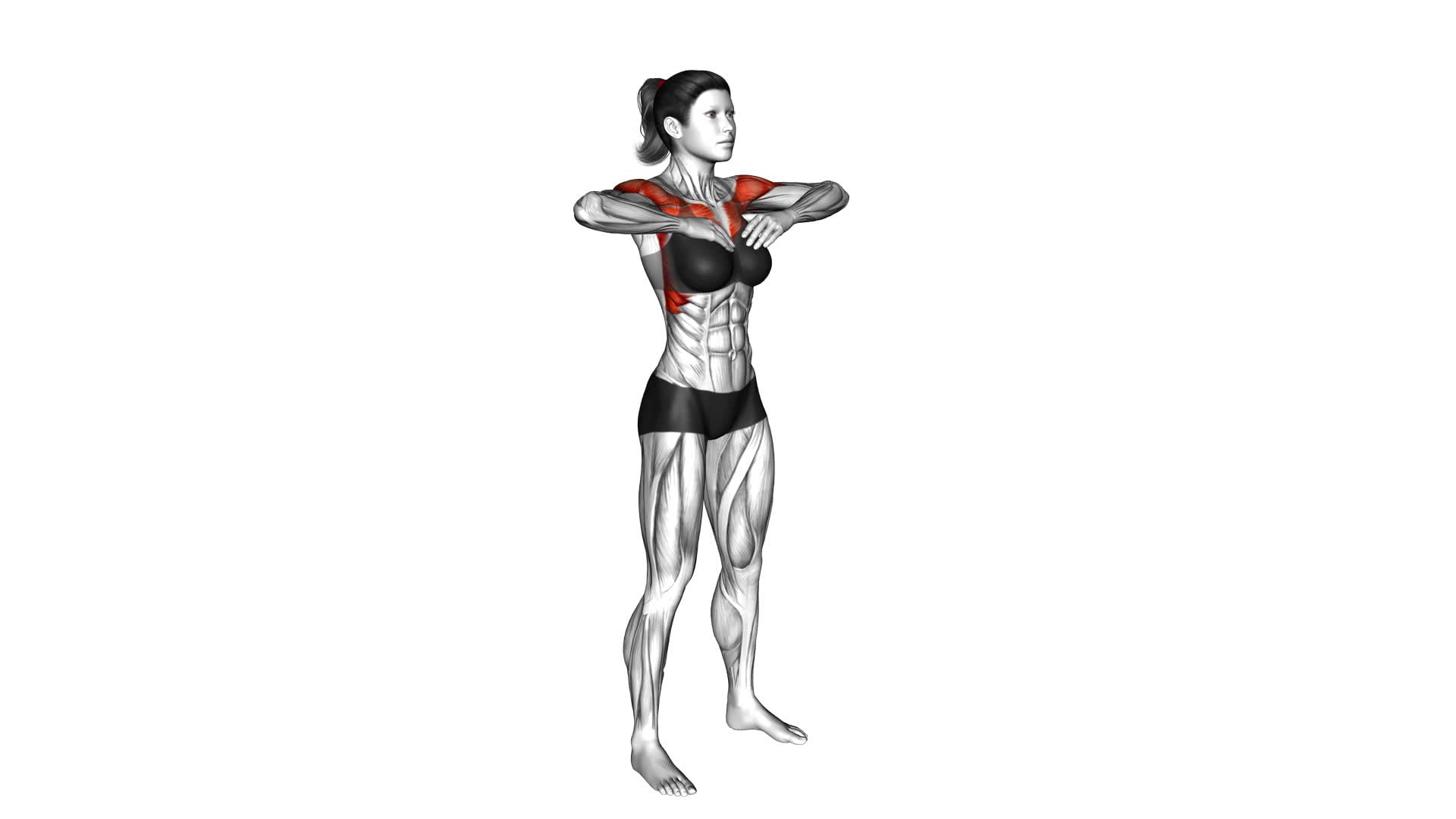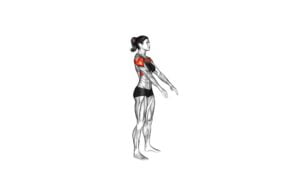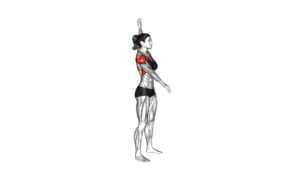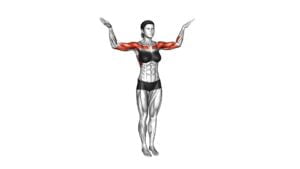Standing Arms Flinging (female) – Video Exercise Guide & Tips

Get ready to tone and strengthen your arms with Standing Arms Flinging! In this video exercise guide, we'll show you the proper technique and form for beginners, as well as advanced variations for experienced fitness enthusiasts.
Watch This Exercise Video
Avoid common mistakes and maximize the effectiveness of this exercise with our tips.
Whether you're looking to build muscle or increase your overall strength, Standing Arms Flinging is a great addition to your workout routine.
Let's get started!
Key Takeaways
- Standing Arms Flinging targets upper body muscles such as arms, shoulders, and chest.
- It helps increase upper body strength and improves muscular endurance.
- It enhances posture and body alignment, improving coordination and balance.
- Common mistakes to avoid include using excessive momentum, locking joints, and poor posture.
Benefits of Standing Arms Flinging
You will experience numerous benefits from practicing standing arms flinging. This exercise involves various variations that target your upper body, specifically your arms, shoulders, and chest muscles. Regular practice of standing arms flinging can help improve your overall strength and muscular endurance.
One of the benefits of this exercise is that it can increase your upper body strength. By repeatedly flinging your arms, you engage the muscles in your arms and shoulders, which helps to build strength over time. Additionally, standing arms flinging can also improve your muscular endurance, allowing you to perform daily activities with less fatigue.
Another advantage of practicing standing arms flinging is that it can enhance your posture. This exercise requires you to stand tall and engage your core muscles to maintain balance and stability. By doing so, you can improve your posture and overall body alignment.
Regular practice of standing arms flinging can also help to improve your coordination and balance. The repetitive movement of flinging your arms requires coordination between your upper body and lower body, helping to enhance your overall body control.
In conclusion, standing arms flinging offers numerous benefits, including increased upper body strength, improved muscular endurance, enhanced posture, and better coordination and balance.
Now, let's discuss the equipment needed for this exercise.
Equipment Needed for the Exercise
To perform standing arms flinging, you'll need some equipment. The most common equipment used for this exercise is dumbbells. When it comes to choosing the right dumbbells, it's important to consider your fitness level and the weight you can comfortably handle. For beginners, it's recommended to start with lighter dumbbells, around 2 to 5 pounds. As you progress and build strength, you can gradually increase the weight.
There are different types of dumbbells suitable for standing arms flinging. One option is the traditional dumbbells, which are available in various materials such as metal, rubber-coated, or vinyl-coated. Another option is adjustable dumbbells, which allow you to change the weight plates according to your preference.
If you don't have dumbbells or prefer not to use them, there are alternatives for performing standing arms flinging. You can use resistance bands, which provide a similar level of resistance as dumbbells. Another option is to use water bottles or canned goods as makeshift weights. These household items can be easily held in your hands and used for the exercise.
Proper Technique and Form for Beginners
To ensure proper technique and form as a beginner, it's important to focus on correct starting positions and avoid common mistakes.
By starting with your feet shoulder-width apart and your knees slightly bent, you can establish a stable base for the exercise.
Additionally, be mindful of keeping your core engaged and your shoulders relaxed to prevent unnecessary strain.
Correct Starting Positions
Start your standing arms flinging exercise with a strong and balanced stance. This is one of the correct starting positions that beginners should focus on.
It's crucial to maintain proper technique and form to avoid common beginner mistakes. Stand with your feet shoulder-width apart, keeping your knees slightly bent. Engage your core muscles and maintain a straight posture. Relax your shoulders and keep your arms extended in front of you. Avoid slouching or leaning forward.
This starting position will help you generate power and stability throughout the exercise. By starting with a strong and balanced stance, you set yourself up for a successful standing arms flinging workout.
Common Beginner Mistakes
Avoiding these common beginner mistakes is essential for maintaining proper technique and form during the standing arms flinging exercise.
One common mistake is using too much momentum instead of engaging the muscles. Remember, the purpose of this exercise is to strengthen and tone your arms, so focus on controlled movements.
Another mistake to avoid is locking your joints. Keep a slight bend in your elbows and knees to prevent strain or injury.
It's also important to maintain good posture throughout the exercise. Stand tall, with your shoulders back and core engaged.
Lastly, don't forget to breathe! Many beginners tend to hold their breath, which can lead to tension and decreased performance.
By avoiding these common mistakes, you'll be able to perform the standing arms flinging exercise safely and effectively.
Now, let's move on to advanced variations for experienced fitness enthusiasts.
Advanced Variations for Experienced Fitness Enthusiasts
For experienced fitness enthusiasts, challenge your upper body strength and coordination with advanced variations of the standing arms flinging exercise. These advanced modifications will take your workout to the next level and help you achieve even greater results.
One advanced variation you can try is the Standing Arms Flinging with Dumbbells. Instead of using just your body weight, grab a pair of dumbbells and hold them in each hand. As you perform the exercise, the added weight will intensify the workout and engage your muscles even more.
Another alternative exercise that can provide a challenge is the Standing Arms Flinging with Resistance Bands. Attach a resistance band to a sturdy anchor point and hold onto the handles with your palms facing down. Step away from the anchor point and perform the exercise as usual, feeling the resistance from the band as you fling your arms.
If you're looking for an even greater challenge, you can try the Single-Leg Standing Arms Flinging. Balancing on one leg while performing the exercise won't only challenge your upper body strength but also improve your balance and stability.
Remember to always listen to your body and progress at a pace that's suitable for your fitness level. With these advanced variations, you can continue to push yourself and achieve new levels of strength and coordination.
Common Mistakes to Avoid While Performing the Exercise
When performing the Standing Arms Flinging exercise, it's important to be aware of the common mistakes that can lead to incorrect form and potential dangers.
One common mistake to avoid is overextending your arms, as this can put unnecessary strain on your shoulders and lead to injury.
Additionally, it's crucial to ensure that you have properly warmed up your body before attempting this exercise, as failure to do so can increase the risk of muscle strains or pulls.
Incorrect Form Dangers
To prevent injury while performing Standing Arms Flinging, it's crucial to maintain proper form. Incorrect form can lead to various dangers and risks.
One of the main dangers of incorrect form is the potential for muscle strain or injury. When you perform the exercise with improper technique, you put unnecessary stress on your muscles, which can lead to strains or even tears.
Another danger is the risk of joint pain or damage. Without proper form, your joints may be misaligned or bear too much weight, leading to discomfort or long-term damage.
Lastly, incorrect form can limit the effectiveness of the exercise. By not engaging the correct muscles or using the proper range of motion, you may not achieve the desired results.
Therefore, it's important to focus on maintaining proper technique throughout the entire exercise.
Overextending Can Cause Injury
To prevent injury while performing Standing Arms Flinging, be cautious of overextending your muscles beyond their natural range of motion. Overextending risks can lead to strains, sprains, or even muscle tears. It's important to maintain proper form and technique throughout the exercise to prevent injuries.
Here are some common mistakes to avoid while performing Standing Arms Flinging:
- Avoid forcefully flinging your arms too far back, as this can strain your shoulder joints.
- Don't hyperextend your elbows, as it can put excessive stress on the joint and lead to injury.
- Be mindful not to overextend your spine, as this can strain your lower back muscles and potentially cause pain.
Lack of Proper Warm-Up
To avoid the common mistake of lacking a proper warm-up, ensure that you adequately prepare your body before performing the Standing Arms Flinging exercise. Preventing injuries is crucial, and a proper warm-up plays a vital role in achieving this goal.
Before starting the exercise, take a few minutes to stretch your muscles. Stretching helps to increase flexibility, improve blood flow, and reduce the risk of strain or injury. Focus on stretching the muscles in your arms, shoulders, and upper back, as these are the areas that will be engaged during the exercise.
Incorporate dynamic stretches, such as arm circles and shoulder rolls, to warm up and activate these muscles. Remember, a proper warm-up is essential for a safe and effective workout.
Tips for Maximizing the Effectiveness of Standing Arms Flinging
To maximize the effectiveness of Standing Arms Flinging, incorporate these tips into your routine:
- Maintain proper form: Stand with your feet hip-width apart, knees slightly bent, and core engaged. Keep your shoulders relaxed and your chest lifted throughout the exercise.
- Start with light weights: If you're a beginner, it's important to start with lighter weights to avoid straining your muscles. Gradually increase the weight as you build strength and confidence.
- Focus on controlled movements: Rather than flinging your arms forcefully, concentrate on controlled and deliberate movements. This will engage your muscles more effectively and prevent unnecessary strain.
- Visualize the movement: Imagine that you're flinging away any stress, tension, or negative energy with each movement. This mental imagery can help you stay focused and motivated during the exercise.
- Breathe properly: Inhale as you raise your arms and exhale as you bring them back down. Don't hold your breath during the exercise, as it can hinder your performance and cause unnecessary tension.
- Incorporate variations: To keep challenging your muscles and prevent plateau, try different variations of the Standing Arms Flinging exercise. You can perform the exercise with resistance bands, increase the range of motion, or incorporate other upper body movements.
Frequently Asked Questions
How Many Calories Can You Burn by Doing Standing Arms Flinging?
You can burn calories by doing standing arms flinging. This exercise involves swinging your arms in a controlled manner, which can help increase your heart rate and boost your metabolism. The number of calories burned will depend on factors such as your weight and the intensity of the exercise.
Standing arms flinging also offers other benefits like toning your upper body muscles and improving your posture. Incorporate this exercise into your routine for a calorie-burning workout.
Can Standing Arms Flinging Help in Toning the Arms and Shoulders?
Standing arms flinging can definitely help in toning your arms and shoulders. This exercise provides numerous benefits for overall body strength. By engaging your upper body muscles, it can help you develop lean and sculpted arms and shoulders.
Additionally, standing arms flinging can be modified for beginners by using lighter weights or starting with smaller movements. Incorporating this exercise into your fitness routine can contribute to achieving your desired arm and shoulder definition.
Is It Necessary to Warm up Before Performing Standing Arms Flinging?
Before performing standing arms flinging, it's necessary for you to warm up. Warming up helps prepare your muscles and joints for exercise, reducing the risk of injury.
Stretching before exercise has many benefits, such as increasing flexibility and improving range of motion.
If you're looking for alternatives to standing arms flinging, you can try exercises like bicep curls or shoulder presses. These exercises also target the arms and shoulders and can be effective in toning them.
Can Standing Arms Flinging Be Incorporated Into a Full-Body Workout Routine?
Yes, standing arms flinging can definitely be incorporated into a full-body workout routine. It offers numerous benefits for your entire body, including strengthening your arms, shoulders, and back, as well as engaging your core muscles.
Additionally, there are variations of standing arms flinging that you can try to add variety and challenge to your workout. By including this exercise in your routine, you can achieve a well-rounded and effective full-body workout.
How Often Should Standing Arms Flinging Be Done to See Noticeable Results?
To see noticeable results from standing arms flinging, it's important to do it regularly. Aim to incorporate this exercise into your routine at least three to four times a week.
By consistently challenging your muscles and increasing the intensity over time, you'll begin to notice improvements in your upper body strength and tone.
Remember to maintain proper form and technique throughout the movement, and don't forget to modify the exercise to suit your fitness level.
Conclusion
In conclusion, standing arms flinging is a beneficial exercise that helps tone and strengthen the upper body muscles. By incorporating proper technique and form, beginners can safely perform this exercise with minimal equipment needed.
Advanced variations provide a challenge for experienced fitness enthusiasts looking to further enhance their strength and endurance. By avoiding common mistakes and following helpful tips, individuals can maximize the effectiveness of standing arms flinging for a well-rounded workout.

Author
Years ago, the spark of my life’s passion ignited in my mind the moment I stepped into the local gym for the first time. The inaugural bead of perspiration, the initial endeavor, the very first surge of endorphins, and a sense of pride that washed over me post-workout marked the beginning of my deep-seated interest in strength sports, fitness, and sports nutrition. This very curiosity blossomed rapidly into a profound fascination, propelling me to earn a Master’s degree in Physical Education from the Academy of Physical Education in Krakow, followed by a Sports Manager diploma from the Jagiellonian University. My journey of growth led me to gain more specialized qualifications, such as being a certified personal trainer with a focus on sports dietetics, a lifeguard, and an instructor for wellness and corrective gymnastics. Theoretical knowledge paired seamlessly with practical experience, reinforcing my belief that the transformation of individuals under my guidance was also a reflection of my personal growth. This belief holds true even today. Each day, I strive to push the boundaries and explore new realms. These realms gently elevate me to greater heights. The unique combination of passion for my field and the continuous quest for growth fuels my drive to break new ground.







